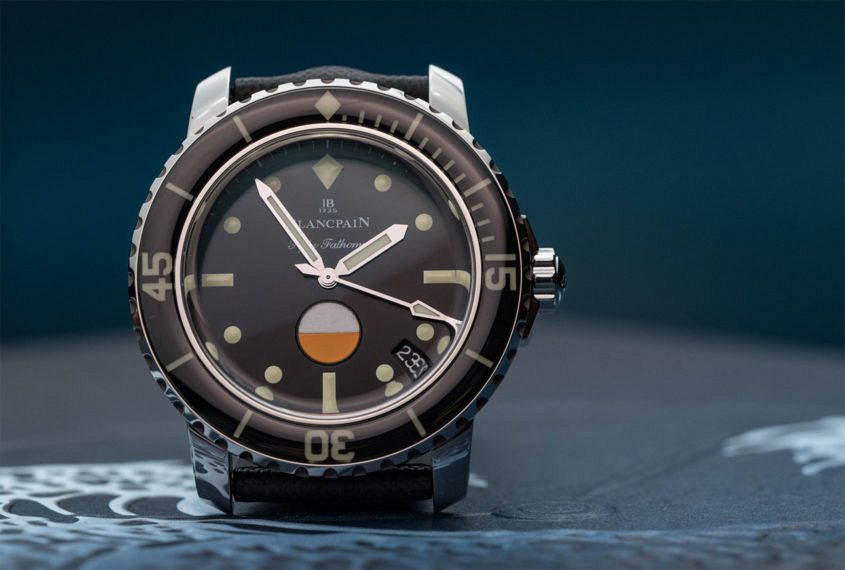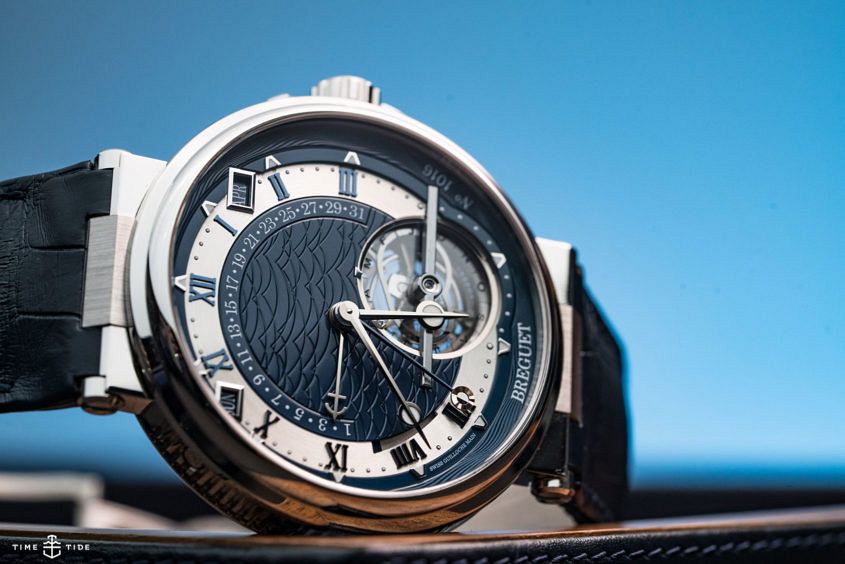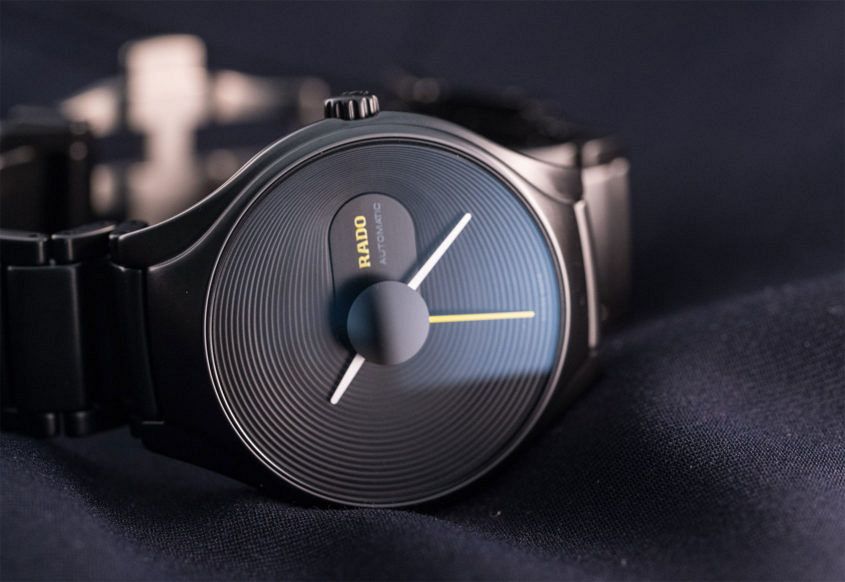VIDEO: 3 of the biggest Blancpains from Baselworld
 If you love dive watches but don’t love the wrist-dominating size that typically goes along with the genre, you’ll want to pay close attention to Blancpain this year. Alongside new 38mm versions of the pared-back Bathyscaphe, they’ve also released a particularly hot limited edition – the Tribute to Fifty Fathoms Mil-Spec. Not only does this heritage-inspired little legend come in at a crowd-pleasing 40mm, it’s also got a funky-yet-functional dial decoration in the form of a moisture indicator. If that bi-colour circle at six changes colour, time to get your watch out of the water and into the service centre. But as you should know, there’s more to Blancpain than the Fifty Fathoms – there’s also a Villeret Day-Date, a good choice for an everyday wearer if your style sits on the formal end of the spectrum.
If you love dive watches but don’t love the wrist-dominating size that typically goes along with the genre, you’ll want to pay close attention to Blancpain this year. Alongside new 38mm versions of the pared-back Bathyscaphe, they’ve also released a particularly hot limited edition – the Tribute to Fifty Fathoms Mil-Spec. Not only does this heritage-inspired little legend come in at a crowd-pleasing 40mm, it’s also got a funky-yet-functional dial decoration in the form of a moisture indicator. If that bi-colour circle at six changes colour, time to get your watch out of the water and into the service centre. But as you should know, there’s more to Blancpain than the Fifty Fathoms – there’s also a Villeret Day-Date, a good choice for an everyday wearer if your style sits on the formal end of the spectrum.
The post VIDEO: 3 of the biggest Blancpains from Baselworld appeared first on Time and Tide Watches.
 If you’re an avid follower of our Instagram stories, you might have overheard my candid thoughts on the new entry level Nomos as we captured some scenic pre-Basel scene-setting. As Andrew live-panned a view of the Rhine, I could be heard distinctly in the background saying, “Ooh, new Nomos … huh, not sure about that.” The reason for my reticence (I’m typically effervescent about my favourite German watch brand) was the dial, particularly those two Roman numerals on the bottom half. First, some background on the Club. This round, slightly less classical Nomos has been a stalwart of their line-up for years. It’s always been billed as a watch for younger people, or your first ‘good’ watch. The Club Campus is, in many ways, the extension of this concept. The proposition of the Campus is that it’s explicitly aimed at students, whether as a watch to wear while you study, or as a tangible way to celebrate your graduation. What this means is that the Campus is a watch that’s been stripped back to the essentials in terms of both functionality and price. The Club Campus is offered in a white-dialled 36mm version and larger 38mm versions in white or…
If you’re an avid follower of our Instagram stories, you might have overheard my candid thoughts on the new entry level Nomos as we captured some scenic pre-Basel scene-setting. As Andrew live-panned a view of the Rhine, I could be heard distinctly in the background saying, “Ooh, new Nomos … huh, not sure about that.” The reason for my reticence (I’m typically effervescent about my favourite German watch brand) was the dial, particularly those two Roman numerals on the bottom half. First, some background on the Club. This round, slightly less classical Nomos has been a stalwart of their line-up for years. It’s always been billed as a watch for younger people, or your first ‘good’ watch. The Club Campus is, in many ways, the extension of this concept. The proposition of the Campus is that it’s explicitly aimed at students, whether as a watch to wear while you study, or as a tangible way to celebrate your graduation. What this means is that the Campus is a watch that’s been stripped back to the essentials in terms of both functionality and price. The Club Campus is offered in a white-dialled 36mm version and larger 38mm versions in white or… Here at Time+Tide we make no bones about being greatly enamoured of Longines’s heritage offerings, so it’s understandable that we made a beeline for the Lindbergh and 1945 models. However, our attention was rapidly drawn to the comparatively pared-back Record, which intrigued us with one simple word on its dial – ‘chronometer’. Now, in case you’re not up with your watch jargon, a chronometer is a essentially a very precise and accurate timepiece. And while in the past the task of certifying chronometers fell to astronomical observatories, these days it’s the duty of Contrôle Officiel Suisses des Chronomètres, Switzerland’s chronometer testing institute. COSC conducts extensive testing of uncased movements over a period of 15 days, ensuring that they achieve an average daily rate of -4/+6 seconds in five positions and at three different temperatures. Some brands, notably Rolex and Breitling, submit all their watches for chronometer certification, but this is the first time Longines has released an entirely COSC-certified collection. The movements that meet this standard are produced by ETA exclusively for the brand, and incorporate a crystal-silicon balance spring. That Longines has committed to this level of accuracy at their competitive price point is impressive, to say the least. So that’s…
Here at Time+Tide we make no bones about being greatly enamoured of Longines’s heritage offerings, so it’s understandable that we made a beeline for the Lindbergh and 1945 models. However, our attention was rapidly drawn to the comparatively pared-back Record, which intrigued us with one simple word on its dial – ‘chronometer’. Now, in case you’re not up with your watch jargon, a chronometer is a essentially a very precise and accurate timepiece. And while in the past the task of certifying chronometers fell to astronomical observatories, these days it’s the duty of Contrôle Officiel Suisses des Chronomètres, Switzerland’s chronometer testing institute. COSC conducts extensive testing of uncased movements over a period of 15 days, ensuring that they achieve an average daily rate of -4/+6 seconds in five positions and at three different temperatures. Some brands, notably Rolex and Breitling, submit all their watches for chronometer certification, but this is the first time Longines has released an entirely COSC-certified collection. The movements that meet this standard are produced by ETA exclusively for the brand, and incorporate a crystal-silicon balance spring. That Longines has committed to this level of accuracy at their competitive price point is impressive, to say the least. So that’s… Breguet may not have had the largest collection on display at Basel, but they certainly had one of the most complex. As well as some handsome new additions to the Classique family, Breguet released an epic new grand complication – the Marine Équation Marchante 5887, a completely new watch boasting a perpetual calendar, tourbillon power reserve and, wait for it… a running equation of time. What’s that, I hear you ask? Well, you’ll have watch the video and find out.
Breguet may not have had the largest collection on display at Basel, but they certainly had one of the most complex. As well as some handsome new additions to the Classique family, Breguet released an epic new grand complication – the Marine Équation Marchante 5887, a completely new watch boasting a perpetual calendar, tourbillon power reserve and, wait for it… a running equation of time. What’s that, I hear you ask? Well, you’ll have watch the video and find out. Seiko’s Prospex series of professional dive watches is renowned for two things: its exceptionally high quality-to-value ratio and its large number of passionate fans. And while there are a few perennial standouts in the Prospex family, some parts of the collection ebb and flow based on style and popularity. One such model is the so-called ‘Samurai’, a contemporarily styled 200m diver produced for a few years from 2004. Released in a range of dials variants, and in steel or titanium cases, the watch earned its moniker because the handset reminded wearers of the distinctive angles of the aforementioned warriors’ swords. Also, it’s an unwritten rule that wherever possible, Seiko model nicknames need to explicitly evoke their Japanese origins. As is so often the case with discontinued models, the Samurai developed something of a cult following, and prices for pre-owned models started, slowly but surely, to rise. So when Seiko announced at Baselworld earlier this year that the Samurai was back as a complete collection, it’s only slightly hyperbolic to say that the people rejoiced. Certainly people who care about well-priced, no-nonsense watches (which it turns out is quite a few) were pretty happy. That’s the backstory, so how about the watch?…
Seiko’s Prospex series of professional dive watches is renowned for two things: its exceptionally high quality-to-value ratio and its large number of passionate fans. And while there are a few perennial standouts in the Prospex family, some parts of the collection ebb and flow based on style and popularity. One such model is the so-called ‘Samurai’, a contemporarily styled 200m diver produced for a few years from 2004. Released in a range of dials variants, and in steel or titanium cases, the watch earned its moniker because the handset reminded wearers of the distinctive angles of the aforementioned warriors’ swords. Also, it’s an unwritten rule that wherever possible, Seiko model nicknames need to explicitly evoke their Japanese origins. As is so often the case with discontinued models, the Samurai developed something of a cult following, and prices for pre-owned models started, slowly but surely, to rise. So when Seiko announced at Baselworld earlier this year that the Samurai was back as a complete collection, it’s only slightly hyperbolic to say that the people rejoiced. Certainly people who care about well-priced, no-nonsense watches (which it turns out is quite a few) were pretty happy. That’s the backstory, so how about the watch?… When you walk into the Rado booth at Basel you can be pretty confident that you’ll see ceramic – and lots of it. This year the brand did not disappoint, offering up their trademark hi-tech watches in a variety of shapes, sizes and colours. There’s the new Ceramica – Rado’s distinctive rectangular design – which has been given an automatic upgrade and a fresh case of matt grey ceramic. Then there’s a brace of True models, made in collaboration with designers of all stripes. Our picks were the topographical True Stratum and the clever bling of the True Blaze. And then of course there’s the obligatory nod to the past, which for Rado means the Captain Cook collection. Several new version were released, including a very faithful reissue as well as a more modern take on the theme.
When you walk into the Rado booth at Basel you can be pretty confident that you’ll see ceramic – and lots of it. This year the brand did not disappoint, offering up their trademark hi-tech watches in a variety of shapes, sizes and colours. There’s the new Ceramica – Rado’s distinctive rectangular design – which has been given an automatic upgrade and a fresh case of matt grey ceramic. Then there’s a brace of True models, made in collaboration with designers of all stripes. Our picks were the topographical True Stratum and the clever bling of the True Blaze. And then of course there’s the obligatory nod to the past, which for Rado means the Captain Cook collection. Several new version were released, including a very faithful reissue as well as a more modern take on the theme.